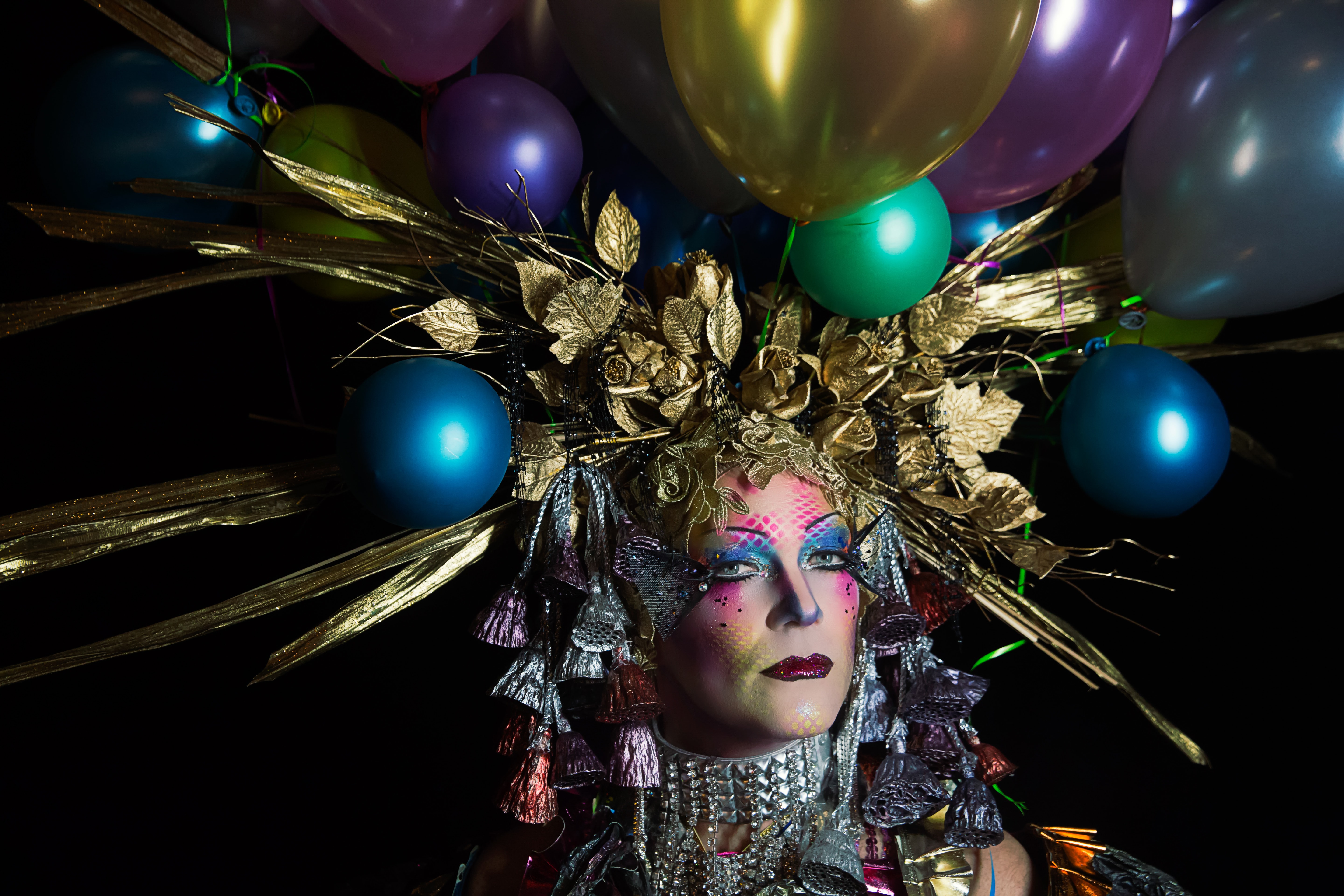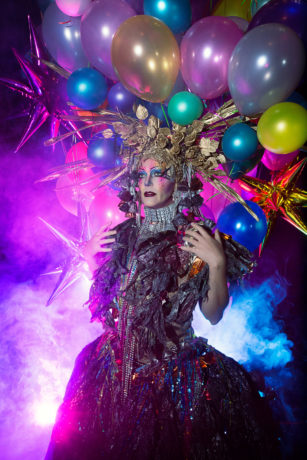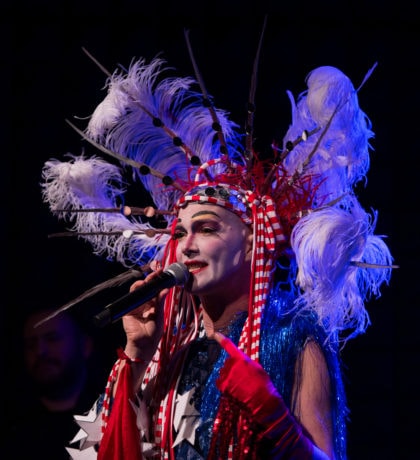I doubt the Eisenhower Theater was ever more queered than the night Taylor Mac came to town. The outrageously gifted and fabulously attired theater artist brought “a radical fairy realness ritual sacrifice” to a cheering sold-out crowd—who at one point were persuaded to pair off in same-sex couples and slow dance.
Whatever Taylor Mac bid, we did. It was as if everything staid and conventional about DC was being delightfully corrupted by a steamroller of queer counterculture.
The two-part program was packed with showstoppers, starting with Mac’s entrance down the aisle wearing a glittery vision in gold featuring shimmering wings, ruby red heels, and a sequined headdress embellished with “In Goddess We Trust.” It was the first but not the last extrava-gown-za from Mac’s longtime costume designer, Machine Dazzle, whose own cameo appearance was in a face-wrapped homage to the flamboyant performer/designer Leigh Bowery.
This would not be “a normal concert,” Mac said, to no one’s surprise. “This is a performance art concert. You can hate everything about this show, and I still will have succeeded.” Which of course was a joke, because the audience was lovin’ every minute. Not least when Mac broke out into an arrangement of “Amazing Grace” so amazing it felt like the second coming of Prince, Jimi Hendrix, and Ziggy Stardust all rock and rolled into one.

The program, Mac announced, would be a selection of songs about resistance since 1776, abridged from the 24-hour version, which played in New York.
The first song in the series was indeed a ditty from 1776 called “The Congress,” which was a treat for anyone fed up with today’s legislative branch. Its unequivocal hook was “execrate the Congress…execute the Congress…curse the haughty Congress…bid adieu to Congress.”
From 1780 Mac reclaimed what he called “the first women’s lib song” (I’m not sure what he meant by that, as it was written in praise of the Queen). And then, as if for bipartisan cred, Mac introduced what he called “the GOP’s favorite resistance song.” When it turned out he meant the blackface minstrelsy classic “Dixie Land,” the audience howled (“Oh, I wish I was in the land of cotton, / Old times there are not forgotten. / Look away, look away, look away Dixie Land!”) Then, astonishingly, Mac brought real feeling to the tune, like a beautifully moving musical reverie. Of course, Mac had a zinger to catch us up and score a point: “Nostalgia is the last refuge of the racist.”

Mac’s patter between and within songs was inimitably quick and witty; and the impromptu theatrical provocations, a hoot. At one point Mac went into the audience, picked out six middle-aged white men, and got them to carry the glam entertainer shoulder-high up to the stage, all the while Mac sang a trumpety disco arrangement of the late 1880s “She’ll Be Coming Round the Mountain.” Whether that was meant as a double entendre, I cannot guess.
Continuing the show’s radical embrace of resistance movements, Mac wrapped references to the black civil-rights movement, the women’s liberation movement, and the queer civil-rights movement into an introduction to the Nina Simone song “Mississippi Goddam” (“You don’t have to live next to me / Just give me my equality”). Accompanied by two powerhouse vocalists (Steffanie Christi’an and Thornetta Davis) and the outstanding orchestra (Danton Boller on bass, Bernice “Boom Boom” Brooks on drums, Viva DeConcini on guitar, Greg Glassman on trumpet, J. Walter Hawkes on trombone, Dana Lyn on violin) under the magnificent musical direction of Matt Ray on piano, Mac’s rendition of “Mississippi Goddam” rocked the house like a truth bomb.
Mac’s persona and programming share some DNA with Charles Ludlam’s Theater of the Ridiculous, but as Mac set up a classic Irving Berlin song, things got not only ludicrous but strangely touching. Explaining that Berlin was a Russian Jewish immigrant who grew up in a crowded New York tenement, Mac cajoled the audience into a “reenactment,” conducting us section by section to make nonsense sounds—squalling infants, gabbing parents, babbling brothers and sisters—as if we were a cacophonic orchestra, all while Mac on the mic milked the irony out of “All Alone.”

After the intermission, a thundering Rolling Stones “Gimme Shelter” jolted us back (“It’s just a shot away / It’s just a shot away”), and Mac worked in a poignant reference to Marsha P. Johnson, the transgender pioneer and activist said to have sparked the queer-rights riot in 1969 when she threw a glass at the mirror in the Stonewall Bar. Punned Mac: “It was the shot glass heard round the world.”
Middle-aged white men, it turned out, were in for more. Mac selected three of them this time and sent them up on stage with instructions to stand center stage and represent “the patriarchy.” This they did with evident good cheer. Then with full-on cheek, Mac sang the Platters’ “Only You” (“Only you can make this world seem right… You’re my dream come true, my one and only you”). Things got very hand-holdy and huggy.
There was still more. Mac introduced a Ted Nugent song (“Snakeskin Cowboy”) that Nugent acknowledged was about fag-bashing (“Who the hell you think you are / You’re dancin’ around with your high-heeled boots / … / Just hangin’ around with your fancy pants on”). And Mac declared: “We have to appropriate that shit.” Thereupon Mac induced/seduced the entire audience into the aforementioned same-sex slow dance. I can’t explain it. You had to have been there.
Then came an entrance even grander than Mac’s: The Bowie State University Pep Band, horns blaring and drums pounding, marched down the aisle in formation and in force and owned the stage to the galvanizing strains of the Staple Singers’ “Freedom Highway” (“We’re marching the freedom highway / And we’re not gonna turn around”).
The word showstopper doesn’t even… But Mac had even more in store, including a big finish inspiration that “the people have the power.”
Something precious and ineffable happened during this show. Not incidentally, Lighting Designer John Torres deployed a lot of red, white, and blue through billowing haze that not only made the house feel part of the stage but made us all feel part of America. It was off-the-charts entertaining and at the same time heart-stoppingly grounded in a politics of inclusion and resistance. Mac got a MacArthur genius grant for good reason. If the nation had a popular entertainer laureate, I’d nominate Taylor Mac.
Before the show, I overheard a patron who had seen the 24-hour version say: “It was exhausting but pretty phenomenal.”) Before being swept away by this two-and-a-half-hour touring edition, I could not imagine wanting 21 and a half hours more.
Now I totally can.
Running Time: Two hours 30 minutes, including one intermission.
Taylor Mac’s A 24-Decade History of Popular Music (Abridged) played March 6, 2018, at the Kennedy Center Eisenhower Theater — 2700 F Street, NW in Washington, DC.
Taylor Mac’s A 24-Decade History of Popular Music (Abridged) was presented as part of Direct Current, a new celebration of contemporary culture, which runs through March 19, 2018, at the Kennedy Center. Tickets and the full schedule are online.





